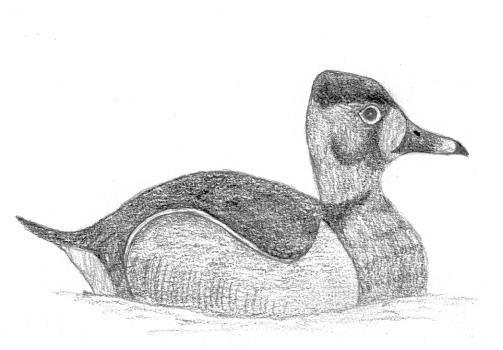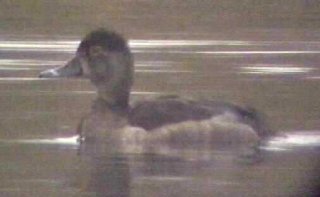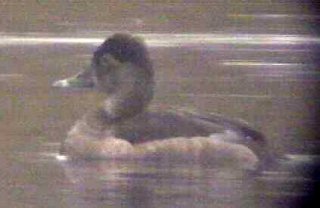Ring-necked Duck at Burghfield Gravel Pits
30 Nov 2001 | Marek Walford
Description
Ring-necked Duck (1st winter female)
Searles Farm Lane, Burghfield Gravel Pits, Berkshire (SU687703)
23rd November 2001
Overcast but bright. Light good but fading after 4pm.
The bird was obviously a diving duck superficially similar to Tufted Duck, of which there were about 100 present, but the overall colour of the bird was noticeable paler, more sandy brown than the females making it easy to pick it out from the flock. It spent most of the time asleep but occasionally raised its head to preen. In doing so it ?rolled?, showing its legs to be un-ringed. Although it never flew it did flap its wings and there was no sign of feather damage as a result of being pinioned. It also dived on two occasions. I watched it at a range of about 150 yards between 15:05 and 16:30 through x10 binoculars and x20 telescope. I phoned the news into Birdnet shortly after 3pm and then phoned Brian Bennett. He was unable to come and have a look but confirmed the features from the Collins Guide. I phoned several other local birders but Mike McCarthy was the only person able to get out of work. He arrived at about 15:45 (x10 binoculars and x25 telescope) and was the only other person to see the bird.
Sexed as a female due to brown plumage of head and mantle. Aged as a first-winter due to dark eye, indistinct pale sub-terminal band on bill, lack of white ?tear line? off white eye ring and buff fringe to loral patch.
Size: Appeared slightly smaller (10-15%) than accompanying female Tufted Ducks.
Head: Distinctly peaked at the rear of the crown. Crown dark brown. Neck and nape paler sandy brown. Distinct buff crescent-shaped loral patch. Very distinct narrow white eye ring. An apparent but indistinct almost complete neck collar formed by darker brown feathers on the upper breast.
Eye: Dark.
Bill: Slate grey. Small black tip. Faint pale sub-terminal band behind black tip.
Upper parts: Mantle, rump and tail all brown. Wings brown with a pale grey wing bar across the secondaries and primaries.
Under parts: Flanks buff/sandy brown. Pale line running along top of flanks. Small notch at the top/front of flanks. Undertail coverts pale but diffuse. Tail raised. Legs dark.
Previous experience of species
14/04/2000: Drake, Oldbury Power Station, Gloucestershire
10/03/1996: Drake, Warnham Pond, Sussex
Elimination of confusion species
Female Ring-necked Duck is only likely to be confused with female and juvenile Tufted Duck and Pochard. It differs from both species in the shape of the head being peaked at the rear of the crown. Tufted Duck shows an obvious ?tuft? at the rear of the crown and Pochard has a rounded head. Tufted Duck is further ruled out in having a white wing bar while Ring-necked Duck has a grey wing bar. Female Pochard also has a grey wing bar but is also grey on the back. Juvenile Pochard is brown on the back and could possibly be confused. However, juvenile Pochards have an olive eye whereas juvenile Ring-necked Duck have a dark eye.
Head shape and bill pattern are the two features considered to vary in hybrids. There was nothing untoward about the bill pattern, showing typical markings of a first winter bird. The head was peaked at the rear of the crown - as expected - but did not show any signs of a slight tuft.
I am 100% certain of my identification. This description and the accompanying sketch have been taken from field notes.

Ring-necked Duck. Burghfield GP. 3rd December 2001. © Ian Lewington

Ring-necked Duck. Burghfield GP. 3rd December 2001. © Ian Lewington

Ring-necked Duck. Burghfield GP. 3rd December 2001. © Ian Lewington

Ring-necked Duck. Burghfield GP. 3rd December 2001. © Ian Lewington
References
Standley et al. (1996) The Birds of Berkshire. Berkshire Atlas Group. Reading.